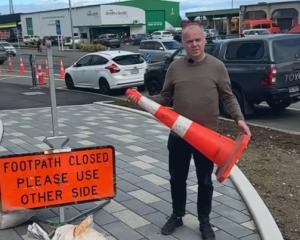
A quick glance at Hansard suggests that a grand total of five questions have been asked to the forestry minister during this entire parliamentary term, but odds-on that is all set to change. In the wake of Cyclone Gabrielle, forestry practices are, unexpectedly, poised to become an election issue.
The minister — Stuart Nash, seeing as you were wondering — announced an inquiry last week into why forestry slash and sediment have caused such devastation in Tairāwhiti/Gisborne and Wairoa during the weather event.
Naturally, the Opposition responded in kind — and National’s Hawke’s Bay candidates Katie Nimon and Catherine Wedd forcefully made the point that forestry slash and sediment had caused damage far beyond the areas prescribed for the inquiry as Mr Nash, also the MP for Napier, would be all too aware.
Also weighing in was National’s forestry spokesman and that person, since January 19, has been Southland MP Joseph Mooney.
Being a lawyer and being accustomed to being handed a brief to understand and speak to at short notice, Mr Mooney made a pretty decent fist of his first pronouncements in his new role — especially given that Mr Nash has an advanced forestry science degree, so is very well-informed.
His first salvo was to support the concept of an inquiry — it would have been difficult for him not to have, given that Labour had, cannily, placed former National cabinet minister and local resident Hekia Parata in charge of it.
However, Mr Mooney was quick to highlight that Mr Nash had already initiated two previous inquiries into forestry slash, one in 2018 which highlighted the potential for just the widespread destruction caused by Gabrielle, and one in 2022 which had reviewed the findings of the 2018 report.
That document sits on Mr Nash’s desk as he awaits advice, and its contents may well make sobering reading in hindsight.
Over the weekend Mr Mooney launched upon a statement by Mr Nash on Q+A that the inquiry would not be about forestry but land use, to claim Mr Nash was at odds with Prime Minister Chris Hipkins on the focus of the inquiry, which he further claimed was being set up for failure.

However, Mr Mooney was right to continue to question whether this is an issue which has been proceeded with in all due haste. Two inquiries in four years does sound reasonable, but the people unable to travel to the supermarket because logs took out their bridge, or who are unable to even get to the fridge because it is buried under a pile of silt, are well beyond the inquiry stage and are — rightly — demanding action.
The plight of those residents is something that Mr Mooney has seen first-hand — having travelled north three weeks ago to see the aftermath of Cyclone Hale for himself, last week Mr Mooney was in Tairāwhiti and the Bay to look and learn.
His photos and video are startling enough at a distance, and will no doubt add some first-hand experience heft should he get to ask the forestry minister his sixth question in the past two years.
For one of his trips Mr Mooney was accompanied by Bay of Plenty MP Todd Muller.
Mr Muller’s portfolios of climate change and agriculture tie in well with forestry and Mr Mooney’s role of associate agriculture spokesman, so expect to see them working closely together this year.
Although Gabrielle will, rightly, dominate the time Mr Mooney dedicates to forestry, there are more than a few local tree-related issues which he may wish to ponder.
For a start, there is the obvious question of whether slash and erosion could afflict the South should a similarly torrential downpour befall us.
Distance from the tropics helps Otago and Southland to a degree, as will the fact most trees here are planted on stable soils, but about 12% of New Zealand’s planted forests are in this part of the country and it has been known to rain heavily in the region from time to time.

More broadly, trees are still being planted aplenty for carbon-sequestration purposes, but those plantations will need to be managed — both their proliferation and their growth.
Most of the region’s forests are in Clutha, and a good chunk of Clutha is in the Southland electorate, so Mr Mooney may be speaking nationally but local issues will be on his mind.
Travelling light
He has not made it to Dunedin since stepping into his new role, but when Mr Hipkins does travel south he has a little something to carry his belongings in, courtesy of the local MP.
Going to the dogs
So, what has Dunedin Labour MP David Clark been doing since announcing his retirement from politics? Reconnecting, very parenthetically, with his electorate and his old job as health minister. He took a day last week to meet a cancer-sniffing canine and also to collect for the Heart Foundation.










